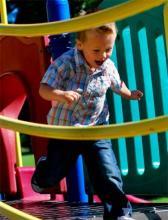
Mobility is the state of being in motion. In children, mobility progresses from crawling as babies to a host of movements, such as walking, running, jumping, and climbing. It takes coordination to develop patterns of movement by integrating visual information with the movement of the limbs. 1The skeletal system, muscles, and the nervous system must collaborate to be able to make the smallest movement, and walking requires fifty-four muscles in the feet, legs, hips, and back working together to propel the walker forward.2
Mobility for infants opens up new worlds to them allowing them to locate and investigate new objects, test new abilities, and begin the process of gaining control over their environment.3 As more children are being placed in childcare settings, the need for infant-toddler playgrounds has led to the construction of playgrounds for children two years and younger.4 The toddler playground supports the development of mobility by stimulating a wide range of movement geared to the child’s developing abilities of sitting, crawling, standing, jumping, grasping, pulling, pushing, walking, running, balancing, and turning.5
Mobility is a challenge to children with physical handicaps. They may be crippled, have congenital defects, neurological disorders like cerebral palsy and epilepsy, or other health impairments. Children with disabilities have problems mastering their physical environments, especially if they are not designed to accommodate persons with physical challenges. Children often have people who are too helpful, too demanding, or who don’t understand their physical difficulties. They may also suffer isolation by being excluded from inclusive play activities because of man-made barriers, both physical and personal.6
The Americans with Disabilities Act (ADA) was signed in 1990 which helps to assure full equality for people with disabilities. This applies to children’s play environments and playground equipment. Accessibility is a primary consideration for designing playgrounds for children with physical handicaps. With paved pathways that wind through the entire playground, ramps to access the play apparatus, and playground equipment with elements designed for the needs of the disabled, all children are given the opportunity to be mobile.7
- 1. Frost, Joe L., Pei-San Brown, John A. Sutterby, Candra D. Thornton. The Developmental Benefits of Playgrounds. Olney, MD: Association for Childhood Education International, 2004. p. 130.
- 2. Yahya, Harun. “Co-ordination In Human Body” Ezine Articles. < http://ezinearticles.com/?Co-Ordination-In-Human-Body&id=947081 > 3 Sept. 2010.
- 3. Frost, Joe L. Play and Playscapes. Albany, NY: Delmar Publishers Inc., 1992. p. 260.
- 4. Wortham, Sue C. “Outdoor play environments for infants and toddlers.” SprinkerLink. Early Childhood Education Journal. Volume 16, Number 4. < http://www.sprinkerlink.com/content/v9m14568r2r78013/abstract/ > 3 Sept. 2010.
- 5. Op. cit., Frost. Play and Playscapes. p. 260.
- 6. Op. cit., Frost. Play and Playscapes. p. 305.
- 7. Op. cit., Frost. Play and Playscapes. pp. 305-306.

